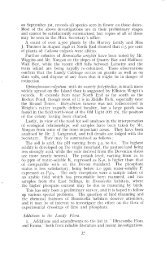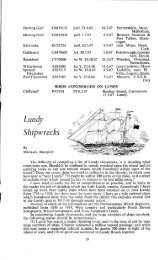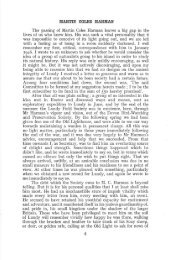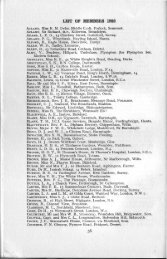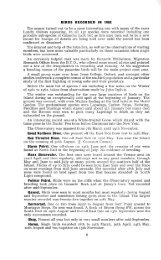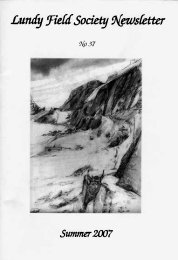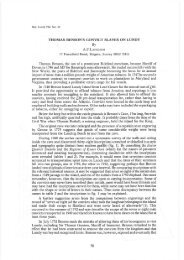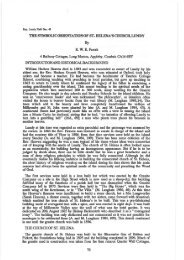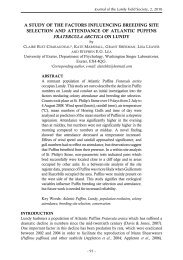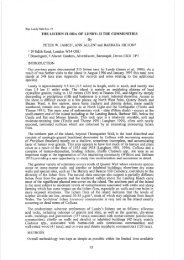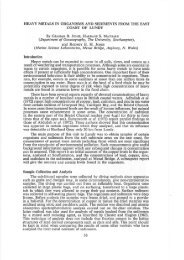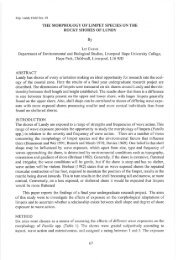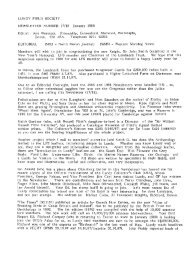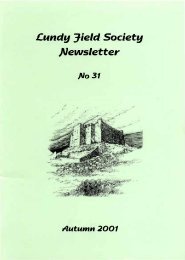Create successful ePaper yourself
Turn your PDF publications into a flip-book with our unique Google optimized e-Paper software.
Irving, RA, Schofield, AJ and Webster, CJ. Island <strong>Studies</strong> (1997). Bideford: <strong>Lundy</strong> Field SocietyISLAND STUDIESattempted to photograph all of the flowers on theisland. Despite some addition s and some losses, thetwo lists tally well.In 1979, I had access to lis ts m ade by Dr F.R.Elliston Wright made in 1933-1935, and published inthe Journal of Botany. In his preface Dr Wright saysthat he considers Loyd's list, which was itself mainlyderived from an earlier list made by Chanter, to be"wholly unreliable". Nevertheless it is interesting thatmost of the plants listed are still to be found there.Dr Wright's outstanding contribution to the study ofthe <strong>Lundy</strong> flora was, of course, the identification ofthat primitive brassica, a fertile hybrid, the <strong>Lundy</strong> cabbage,successively named in the scientific terminologyBrasstcella wrightii in 1936 by Professor O.E. Schultz,and then amended subsequently to first Rhyncosinaplsand then Coincya wrlghtll. A number of articles haveappeared in the Annual Reports on the <strong>Lundy</strong> cabbage(Marren 1971; Cassidi 1980; Irving 1984), all of whichdemonstrate convincingly how the plant has extendedits range from its original locality on the metamorphicDevonian slate northwards along the granite sidelandsas far as Knight Templar Rock. A note in the 1993Annual Report suggests a total of 3,000 p lantsbetween the Landing Bay and Quarter Wall.In the 1982 Annual Report, an important article onthe <strong>Lundy</strong> vegetation appeared, written by Trudy A.Watt and K.J. Kirby (Watt & Kirby 1982). This took theform of a systematic survey of the whole island withsampling of one metre squares at 200 m intervals on143anE-W axis and 500 m intervals on aN-Saxis. Therewere 45 sampling plots in all. The survey demonstratedthe differences in vegetation between the east andthe west sides. It is a valuable addition to the study ofthe island flora but because of the limitations of thesampling method, many prevalent species wentunrecorded. In the 30th Annual Report (Watt 1979),Trudy Watt reported a survey of the grass growth on<strong>Lundy</strong>. This was followed a few years later by R.Takagi-Arigho publishing a list of the grasses found onthe island between the months of May and October(Takagi-Arigho 1986).Preliminary work by Mr P.O. Garbutt and Professorand Mrs Harvey, quoted in the 5th Annual Report(1951), on the differences in plant population betweenthe east and west coasts, was followed in the followingyear by a more detailed study of the slopes on thenorthern aspect of Jenny's Cove on the west side, andthe north flank of Brazen Ward on the east side. Thegradients of the slopes and the pH and chloride contentof the soil were measured, with the frequency ofvarious species being noted against these parameters.A vegetation survey was carried out in 1971 byAlice Dunn and Helen Bristow (Dunn & Bristow 1971 lwith the .aim of helping Colin Taylor complete a map ofthe island vegetation. He had already surveyed thesouth end and the cultivated fields. They studiedAckland's Moor, Pondsbury, Middle Park and theNorth End.In 1973, Paul Wilkins and Julian Debham under-Copyright (1997) <strong>Lundy</strong> Field Society and the author



